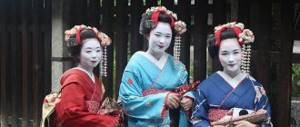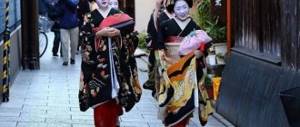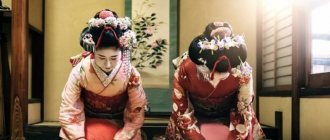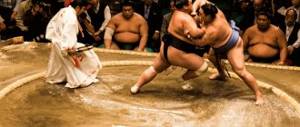“One of the secrets of seducing geishas is to create an aura of exclusivity around themselves.”
Photo by Getty Images
The image of a geisha, a woman in the traditional national costume of a kimono and with a characteristic complex hairstyle, has become a real symbol of Japan. The beauty entertaining guests in the tea house, pouring sake and conducting small talk is not just a costumed character. This is a living embodiment of the primordial traditions of the Land of the Rising Sun. Moreover, a modern woman has a lot to learn from Japanese geishas. Despite the fact that geisha were not women for carnal pleasures, they knew how to turn heads. Let's take into account the main secrets of seduction of Japanese geishas
Natural flowers
The original Japanese entertainment culture, which includes both geisha and prostitutes, was not for nothing called “karyukai,” which means “world of flowers and willows.” And the neighborhoods in Kyoto, Osaka and Tokyo where geisha lived also bore a flower name - “Hanamachi”, which means “city of flowers”.
Photo by Getty Images
Imagine the life of a Japanese man a couple of centuries ago: first he strictly obeys his parents, then his elders, more noble nobles or military leaders. The main thing in his life is duty, and all his actions are subordinated to the fulfillment of this duty.
He took his wife not out of love, but by the decision of his parents, and if he was lucky, then at least he wasn’t disgusted by her. A man constantly experiences strong nervous tension, and he needs to relax at least sometimes.
Well, we know that prostitution has existed in Japan from time immemorial, but the physical joy of a paid woman is not enough for a self-respecting man. He attends pleasure banquets in tea houses with other men of his circle. It was not customary to take legal wives, guardians of the hearth, to such parties, and it was simply unthinkable at that time. But how nice it is when a banquet is decorated by beautiful and educated women with whom it is interesting to talk!
But in the harsh world of samurai there must be a place and time for sublime pleasures, which is why messengers from the “world of flowers” were needed.
At first, the entertainment and banquet function was taken on by kabuki actors, also men, and over time women appeared, existing specifically to shine at parties, pour sake and tea, and, of course, maintain a witty conversation.
Perhaps this is the first secret of the geisha’s attractiveness - her special status. She's not your wife and you don't owe her anything. She is not a prostitute, and there is nothing to despise her for; it is not a shame to sit next to her at the table. This is a woman for the soul, not for the body or life.
Pleasure Districts: Prostitution in Japan
The Yoshiwara quarter appeared in Edo (modern Tokyo) in 1617 thanks to Shoji Jin'emon, the owner of one of the brothels. Before this, the girls worked in tea houses and baths, but in 1612 Shoji sent a petition to the government, in which he proposed to completely reshape the capital’s sex business, creating a separate closed territory for it.
Jin'emon justified his idea with several arguments: firstly, the appearance of brothels corrupts the townspeople and leads to a decline in morality and ethics, secondly, a separate quarter will make it possible to control women and their clients, thirdly, the creation of such a “town” will give the government a new and a very effective tool for espionage.
“Sounds convincing!” - the officials decided, and in 1617 Shoji received two and a half hectares for construction and the title of keiseimatinanushi, becoming the first head of the brothel district in history.
Yoshiwara resembled a real prison: it was surrounded by high walls and a deep moat with water. Yujo girls were allowed to leave him only for four reasons: in the event of the death of their parents, to visit a doctor, to be summoned to court, and to accompany a client during the Hanami cherry viewing festival. Yujo had the right to walk only barefoot; they were always accompanied by the servants of the owner of the brothel. The yarite guards spoke to the officials: the yujo were obliged to remain silent.
Photo: Cosmopolitan In the 18th century, 1,750 girls lived in Yoshiwara—more than half of the 3,000 women in prostitution in Japan. There was an active fight against the “individuals”: they were raided, and all those caught were taken to the quarter. But the main source of traffic was not such “raids”, but the trafficking of women.
Girls from poor families were sold by their parents, ended up in brothels and orphans. Women of the noble class could be sent to the pleasure quarter as punishment. Sometimes wives were sent to Yoshiwara by their husbands, who hoped to improve their financial situation in this way, or by lovers who were bored with the living toy. Girls who ran away from cruel husbands also ended up in Yoshiwara.
The quarter consisted of many brothels. Girls, with the exception of the most expensive ones, sat on verandas covered with bars, men walked along the streets and looked at them, choosing their mistress for the night.
It was forbidden to enter Yoshiwara with weapons. Algernon Mitford in his book “Traditions of Old Japan” wrote: “There are two reasons for this - firstly, to prevent armed clashes, and secondly, because everyone knows that some of the women living there hate their own existence to such an extent that they are ready to put an end to it if only they can get their hands on weapons.”
Formally, a woman could leave the “pleasure quarter” by buying herself out of the brothel owner. However, in reality this was impossible: the debt for education, clothing, cosmetics and food grew so large over time that only a few girls could collect money to pay it off - the so-called oiran, who were considered the elite of the quarter and were the most expensive among its inhabitants.
You will recognize her from a thousand
The appearance of a geisha is also a set of strict rules, and Japan would not be Japan if it were otherwise. Therefore, one of the strengths of a real geisha is discipline.
The two-layer kimono is tied with a belt, which is tucked into a complex knot on the back, so the geisha cannot dress herself; she needs assistants. For comparison, prostitutes tied their kimono at the front with a simple knot to make it easier to untie it several times a day.
Geisha shoes are special geta sandals that are worn on white socks. In all their complex attire, the young students practiced a special mincing gait every day.
Secretary Verochka spoke about the same thing in the film “Office Romance,” criticizing the businesslike gait of women: “And now she’s itching to go to work, as if she’s going to drive piles into her!”
Geisha walked in small steps - they are not maids to walk with strides! And Japanese men reacted to this gait as a signal: a beauty is stepping!
Traditional geisha makeup now seems strange, as if flour was sprinkled on the face. But the Japanese of the last century and the century before last believed that a whitened face, on which the eyeliner stands out brightly and the scarlet flower of painted lips blooms, is mysterious and beautiful.
For the sake of this mystery, geisha were etched with zinc white for centuries until they invented more gentle cosmetics.
The “uniform” of a special woman, the makeup and gait of a special woman - all this had a mesmerizing effect on men. One of the secrets of seducing geishas is to create an aura of exclusivity around themselves.
“Beauty and pain are inseparable for us”
Photo by Getty Images
The geisha's hairstyle is another cross that “women for the soul” have carried all their lives. The complex three-dimensional structure was decorated strictly according to the canon with hairpins, ribbons, flowers or pendants. Skilled hairdressers combed the strands with wax and a fastening compound, laid them in large rollers and secured them with hairpins. Geishas took care of their beautifully styled heads and, to preserve their hairstyle, slept with their heads on a special wooden stand. From an early age they got used to the fact that beauty requires sacrifice.
In the famous novel “Memoirs of a Geisha,” one of the heroines, the popular geisha Mamea, says to her student Sayuri: “Beauty and pain are inseparable for us: your legs will hurt, your fingers will bleed, even sitting and sleeping will hurt.”
Torment for the sake of beauty, which men do not know about, is another special secret of geishas. Clients at banquets saw fresh, friendly, smiling beauties, but they knew nothing about the effort with which this beauty is achieved.
The end of the house of Iwasaki okiya
Photo: Cosmopolitan At the age of 29, the girl gave up her career as a geisha.
She was still popular, but the workload was taking its toll: at 30, Mineko felt like an 80-year-old woman. There was another reason: what Mineko loved most about her work as a geisha was dancing, but the rules limited her ability not only to perform, but even to choose the repertoire and accessories. With her “retirement,” Mineko hoped to draw attention to how strictly regulated the life of geishas was, and after her, 70 more girls left the profession. However, this did not affect the traditions in any way: the rules remained unchanged. Mineko closed the Iwasaki okiya, which by that time had been inherited by her, and built a three-story building with a restaurant and club in its place. Being a geisha, the girl earned up to 500 thousand dollars a year, so she had the start-up capital to become a successful entrepreneur.
It's funny, but it was business that brought Mineko together with her future husband. Having decided to study the beauty industry, she met a stylist, and when she saw a masterfully painted picture of a nine-tailed fox on his wall, she could not contain her delight. Soon the stylist’s wife introduced her to the author, the artist Jinichiro Sato.
After several weeks of meeting at parties, Jinichiro proposed to Mineko, but she rejected him. Sato did not give up: the second, third, fourth followed... In the end, Mineko agreed, but on the condition that he would give her a divorce immediately if she felt unhappy.
In 1982, the lovers got married, and a year later their daughter Kosuke was born, or simply Coco, as her parents called her. The couple built a house in the suburbs of Kyoto. Mineko was finally able to dance wherever and whenever she wanted, and also began to paint. Now the most famous geisha is 71 years old, and her husband continues to call himself the happiest man in the world. Of course, he lives with the woman that all Japanese men dreamed of.
Man of art
When pretty and smart girls were sold to study geisha skills, they settled in the so-called “okiya”, the owner of which was a former geisha. The girls helped with housework, served active geishas (who supported the okiya with their earnings) and learned various arts - dancing, singing, playing national musical instruments - the shamisen (lute), the fue flute. Also, young debutantes were taught the art of the tea ceremony, ikebana (the secrets of arranging bouquets), calligraphy, and painting.
So, a geisha had to be able to sing and dance - what if the guests at the banquet wanted to enjoy her artistic talents? True, guests from Europe and America were perplexed by the singing and dancing of geishas.
The pantomime dance, where every movement has a meaning, was incomprehensible to foreigners. And the singing was not impressive - too quiet and nasal, “like a cat meowing.”
But it is enough that all this was appreciated by the geisha’s compatriots.
Beauties could provide food at feasts, but they themselves never ate in the presence of men. They could pour sake, but getting drunk yourself would mean losing your job. Because of this, geishas seemed to guests to be unearthly, airy, intangible creatures. It is not for nothing that from childhood they were taught to think more often about cherry blossoms, and not about fried pork - so that sublime thoughts would illuminate their faces from the inside.
Geisha had special skills that other women did not learn - another secret of their attractiveness to men. In addition, they sacredly guarded their mystique .
How Masako Tanaka became Mineko Iwasaki
Photo: Cosmopolitan Masako was born in Kyoto on November 2, 1949 in the family of a bankrupt aristocrat, Shinezo Tanaka. At the time of the girl’s appearance, Shinedzo was running a small shop where he sold kimonos, which he painted himself. There was not enough money, and Masako’s father had already sold his daughters to geisha several times in order to replenish the family budget. The Iwasaki okiya house received five Tanaka sisters: Yaeko, Kikuko, Kuniko, Tomiko and, finally, Masako herself.
How Masako charmed Iwasaki’s owner Madame Oima is anyone’s guess, but when she saw the girl for the first time, she immediately said that she wanted to adopt the baby and make her her heir. Masako's father refused for a long time: he did not want his youngest daughter to become a geisha. But Madame Oima insisted, explaining the opportunities that would open up for Masako in her home, and eventually Shinezo gave in. This is how Masako received her new name, under which the whole world recognized her: Mineko Iwasaki.
Mineko's training traditionally began at six years, six months and six days. An experienced geisha was assigned to her as a mentor, and her sister Yaeko was appointed as the girl’s curator. However, this only ruined the child’s life: to put it mildly, they did not get along with the quarrelsome relative.
Mineko studied traditional Japanese kyo-mai dancing and singing, learned to play the shamisen, tsuzumi and koto, as well as calligraphy, etiquette rules and the intricacies of the tea ceremony. Most of all, she loved dancing - the girl had a natural talent for it. Mineko carried her love for this art throughout her life: she even showed her skills to Maya Plisetskaya, who was interested in kyo-mai during a trip to Japan.
The girl was also sent to a regular school. By that point, she was already used to being “one of the Iwasakis.” The new family had its advantages: Mineko got everything she wanted. She simply went into the store and took what she needed - all she had to do was say: “This is for Iwasaki from Shinbashi.” “I didn’t know what money was. For years I believed that if you need something, you just have to ask,” Mineko later wrote in her book.
She mastered Mineko and the geisha lifestyle. The girl slept on a varnished rectangular wooden pillow so as not to spoil her hair, and rice was scattered around the maid. Those who tossed and turned in their sleep woke up with grains in their hair, and were forced to go to the hairdresser again the next morning. Mineko also got used to numerous sharp hairpins: Aunt Oima explained that they are needed to protect against attack, and corals help check whether sake is poisoned: they are destroyed when they come into contact with poison.
She made her debut as an apprentice geisha Mineko, while still a teenager: the girl herself weighed 36 kilograms, her kimono weighed 19, and she had to balance on high six-inch sandals. Having received the right to attend banquets with clients, at the second event Mineko almost disgraced herself: forgetting about everything, she rushed to the glass display case to admire the collection of dolls, losing a bottle of sake in the process. Luckily, the guests found her antics charming rather than offensive.
What about talking?
One of the main and valuable skills of geishas is the art of conversation. This is a man's world - Japanese women realized this a long time ago. A man gets tired at work and in war, but a woman must please his eyes, ears, smell and, of course, mind. Cultured, developed women who could support conversations on any topic were invited to the highest receptions.
In addition, beauties in kimonos learned to be subtle psychologists. When communicating with clients, they always tried to be restrained, even, and friendly. The men relaxed, receiving refined, polite compliments from the beauties. At meetings, important issues of politics and business were sometimes discussed, so geisha learned to keep their mouths shut and keep information about what they heard to themselves.
When a woman shines like the sun towards a man and is ready to listen to him carefully, he will definitely appreciate it. This is also an important secret of seducing geishas.
A little erotica
Of course, high-ranking clients, succumbing to the charms of geishas, took mistresses from representatives of this class. But at banquets the relationship never went beyond light flirting. Geisha is a master of subtle hints, not broadcasting into a loudspeaker.
“You have a very nice hand and wonderful skin. “You must make sure that every man sitting next to you sees your hand at least once during the evening,” the experienced Mamea instructed young Sayuri in the book “Memoirs of a Geisha.” “The most pleasant part of the hand is the inner one, so you should hold the teapot in such a way that the man sees first of all the inner side of the hand.”
Geishas only subtly hinted to men that they were actually not only good at conversations. Overt expressions of sexuality were left to women selling themselves on the street.
Touch
The hands of the mistress of love ran over her partner’s body, caressing and pleasing him, and her body pressed and moved away a tiny distance in order to touch and press against him again, so much so that the man was seized with increasing desire and excitement.
- Light touches, stroking and erotic massage became a prelude to subsequent unforgettable sensations. Hugs are important in love play because they help partners exchange sexual energy, which is important for obtaining harmonious pleasure.
- Geishas knew how to alternate hugs, chest touches, thigh touches, intertwining (when not only the body and arms are involved, but also legs), a full embrace in a lying position, when a man and a woman merge into a single whole
The geisha has always been at the center of Japanese erotic painting.
Oral sex
Geisha were masters of oral sex. Oral sex is very important in Eastern culture because, thanks to the secreted fluids, partners directly exchange male and female energy. And this is important not only in sex, but also for maintaining mental balance, internal harmony and a healthy long life.
IMPORTANT: Geisha is a master of love manipulations with the penis. Inna can play with it with her lips, place it deep inside herself and then sharply push it out, kiss the head, suck. The man is in bliss and frenzy
Sex positions
During the act, a geisha uses different movements of her body to increase both her and the man's pleasure. She can move in time with him, or, on the contrary, she can make movements that seem to impede the movement of the man’s body, which gives him pleasure.
- During the act, partners change positions, lengthening the act, finding the most advantageous positions for pleasure, bringing the man to the ultimate frenzy
- The most popular positions among geishas were in a position where the geisha sat on a man (lying, sitting on his knees), and he penetrated her
- Geisha actively participated in the love ritual, in movements during sexual intercourse. Important in her art was mastery of the internal muscles of her genital organs, which she trained specifically to give a man as much pleasure as possible
By the way, geisha love rituals have their own poetic names, which makes love games not just sexual acts, but also emphasizes their aesthetics.
Geisha experiment with sex positions.
For example, love positions are called:
- "fluttering phoenix"
- "mystical bird"
- "unwinding silk"
- "leaping white tiger"
- other
Kisses could have names like:
- "corals and pearls"
- "pearl rosary"
- "touching the wings of a butterfly"
- other
Japanese punctuality
Perhaps it is worth noting one more important point that makes a geisha even more attractive. The fact is that a Japanese woman in a traditional dress only looks like a porcelain doll. This is deceptive decorativeness. The difficult natural conditions on the islands and the constant struggle for survival and for a place in the sun made Japanese women very strong, resilient and practical. If these are magnolias, then they are truly “steel”.
A quote from Valentin Pikul’s novel “The Three Ages of Okini-san” would be appropriate here:
“Now, during the entire stay in Nagasaki, I am calm for you: there has never been a case where a young officer who married a Japanese woman was late for his watch!” This is what one Russian sailor said to another when he, while serving in Japan, took himself a “musume” - a temporary wife from local women. And indeed, temporary Japanese wives took care of their Russian husbands as if they were spouses for life. And they always made sure that their “husband” did not have unnecessary worries - they themselves kept track of the time and hired a boat so that the sailor was delivered to the ship without delay.
A woman can be very beautiful, but this is not a guarantee that she can be just a decoration all her life. Japanese geishas understood this very well, and therefore successful clients often took them as wives. The most valuable quality of a Japanese woman is that you can rely on her.











